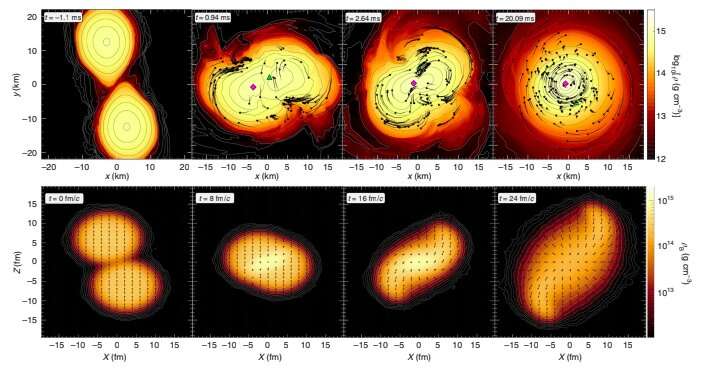August 20, 2019 feature
Measuring temperatures similar to those occurring in star collisions in the lab

Collisions between neutron stars are fascinating cosmic events that lead to the formation of numerous chemical elements. Temperatures during these collisions are exponentially high, typically reaching up to hundreds of billions of degrees Celsius.
The HADES collaboration, a large team of researchers working at different universities worldwide, has recently gathered the very first measurement of the thermal electromagnetic radiation produced during star collisions, known as black-body radiation, in a laboratory setting. Their study, outlined in a paper published in Nature Physics, has led to the observation of temperatures of approximately 800 billion degrees Celsius, which are comparable to those occurring during star collisions.
"In our study, we smashed nuclei (e.g. gold nuclei) at relativistic energies head on," Joachim Stroth, spokesperson for the HADES collaboration, told Phys.org. "This produces forms of matter under conditions not existing normally. Only neutron stars reach such densities (or even higher) and when neutron stars merge, their temperature can get as high as in our experiment. That is why we can form a cosmic type of matter in the laboratory."
In their study, Stroth and his colleagues used the HADES detector system at the GSI/FAIR accelerator center in in Darmstadt to gather new insight into the collisions of two heavy nuclei at relativistic energies. This allowed them to gather in-depth lab observations of the microscopic properties of extreme, cosmic-like states of matter.
The researchers specifically created quantum chromodynamics (QCD) matter as a transient state by colliding heavy ions at relativistic energies. This type of matter can exist in different phases depending on a series of factors, including temperature, pressure and baryochemical potential.
By observing the states of QCD matter, the researchers hoped to gain a better understanding of neuron star matter and collisions. A key question that they set out to investigate was whether the constituents of nuclei, which are essentially the building blocks of matter, can change their properties under extreme conditions.
"We measured the electromagnetic radiation thereby emitted from the fireballs formed in the collision," Stroth explained. This radiation can tell us a lot about the properties of the constituents. However, this is a difficult measurement to attain, as the fireballs live for very short time (10-22 s) and the radiation is rarely emitted."
Hadrons are composite particles made of three quarks (baryon) of an antiquark and a quark (meson) held together by the strong force. When these particles decay, they sometimes produce virtual photons, which are photons that cannot directly be detected because their existence violates conservation of energy and momentum.
These virtual photons, which carry all information about the decayed subatomic particles, also immediately decay into pairs of electrons (i.e. an electron and a positron). In their study, Stroth and his colleagues detected these particles using a spectrometer.
"We observed that the temperature in the collision zone can reach 800 billion degrees and the density can be as high as three times nuclear saturation density," Stroth said. "We find that under such condition the building blocks of matter are substantially modified. This also means that the matter properties are much different, as if the building blocks just retain their properties."
The HADES collaboration is the first research team to successfully measure temperatures similar to those occurring during star collisions in a laboratory setting. This team's findings could significantly enhance the current scientific understanding of neutron star merger events, while also shedding light on the production of matter from elementary quarks and gluons.
"We are currently building a successor experiment for HADES which will be operated at the new FAIR facility starting in 2025," Stroth said. "With this detector we will be able to extend the measurements to higher temperatures and density."
More information: Probing dense baryon-rich matter with virtual photons, Nature Physics (2019). DOI: 10.1038/s41567-019-0583-8
Journal information: Nature Physics
© 2019 Science X Network



















